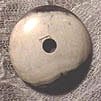Pewter: In the late 18th & early 19th centuries, pewter was used for buttons in men’s fashions, but by 1830 the brass button replaced the pewter button. Pewter buttons appeared again in the late 19th century, however, this time in ladies’ fashions.
Brass: An alloy of copper and zinc, brass has been used to manufacture more buttons than any other material. The brass button industry peeked between 1820 & 1850. This period is often called the “Golden Age” because of the superior quality of these buttons.
Ivory: Ivory is the hard, white dentine which makes up the tusks of elephants, whales, walruses and hippopotamus. Because of its rarity, manufacturers began to use animal bones to imitate expensive ivory buttons as early as the 18th century.
Silver: Silver buttons became fashionable in the mid 1800s through the early 19th century. In the 19th century silver buttons were large and made for men’s overcoats.
Celluloid: First used as a substitute for tusk ivory and wood. Buttons constructed with celluloid parts appeared in the 1897 Sears & Roebuck catalog. These buttons are rather fragile.
Bakelite: Bakelite buttons became very stylish about 1940 to 1950. They produced a fresh warm feel, the color combinations were delightful.
Lucite: Lucite, the trade name of synthetic thermoplastic acrylic resin, was used to make buttons in the mid 1930s. Lucite was produced by DuPont Plastics in Arlington, New Jersey. During World War II, Lucite was used to make gun turrets as well as other practical home items.
Wood: The earliest surviving wooden buttons are smooth, turned discs mounted with nailhead shanks made during the 18th and early 19th centuries.
Horn: Horn buttons made from both the hooves and horns of cattle and other animals. Most molded horn buttons were dyed black or dark brown. After 1880 fewer black molded buttons were made in favor of more natural colors.
Vegetable Ivory: First presented at the 1862 Universal Exposition in Paris, “vegetable ivory” buttons were carved from the corozo nuts of the tague palm. The material resembled ivory, therefore “vegetable ivory”. The material was so dense, the dye would only penetrate the surface layer, the interior remains uncolored. Production reached a peak between 1870 and 1920.
Hard Rubber: In 1839, Goodyear secured a patent for vulcanization, a process using extreme heat and sulfur with hard rubber to form products. One famous rubber button was the “Anchor” design with border stars which was originally manufactured for Navy peacoats.
Mother-of-Pearl: Pearl buttons are made from the nacreous (pearly) lining of shells of various marine or freshwater mollusca found principally in warm waters. Freshwater pearl buttons have less iridescence than ocean pearls. Eighteenth century pearl buttons were large (approximately 1-1/4 inches) and considered the most beautiful ocean pearl buttons ever made.
Shell: Shell is a term used by American collectors to differentiate buttons made from mollusca shells rather than nacreous (pearly) linings. The earliest buttons were cut from the white layer, the grey or brown portions were considered to be inferior. It was not until after 1800 that brown or grey shells were used.
Passemeterie: Named for the 18th century design of fabric buttons, these buttons were faceted pieces of black glass soldered or riveted to a metal back to form an open work design. Quite rare.
“Jet” and Black Glass: Prince Albert of England died in 1861 and Queen Victoria, the fashion setter of the times, went into mourning. Her mourning jewelry and buttons were made of “jet”, a light weight, highly fragile, expensive mineral mined in Whitby, England. Overnight, the black glass industry became highly active. Black remained the predominant fashion color for over two decades. True “jet” is rare and feels warm to the touch.
Luster Finishes: Luster is a metallic sheen applied to black glass buttons for a wonderfully, unique look.
Calico: Calicoes refers to China buttons painted with the designs of the calico fabric. “Calico” fabric made by the Calcutta Indian Company about 1840.
Molded Glass: Fancy glass buttons of the late 19th century were molded clear with paint or transfer designs applied to the back.
Moonglow: Moonglow buttons have opaque bases which give the illusion of swirl or eye in the center and made between 1940 and 1960.


















